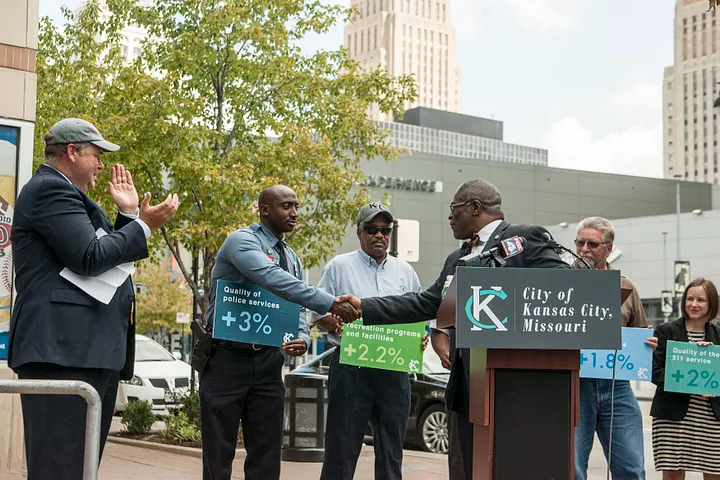Kansas City, Missouri, USA
Project Type:
Community Engagement, Communications, High-Performing Government, Infrastructure
This data narrative was written in 2020 in collaboration with the City. Please be aware that certain information may have changed since then.
At a Glance
Used a quarterly citizen survey that identifies resident priorities from repairing infrastructure to meeting city services.
Hosted an art show by local artists using city data sets that improved community engagement by enabling residents to see and interact with data in a new way.
Invests in transparency by sharing data and demonstrating progress towards goals in the city’s open data portals and other platforms.
Kansas City’s Use of Data
There’s a lot of good news in Kansas City, Missouri: steady population growth, decreasing unemployment, a vibrant downtown, millions in residential development, and a new streetcar that is drawing economic activity downtown. But the City has struggled to keep up with infrastructure issues, including sidewalk and road repair and hundreds of dilapidated buildings that affect safety, property values, and neighborhood livability, impeding Kansas City’s goal to rebuild and enlarge its urban core.
The City has had a great advantage in tackling its challenges, however: its feisty, bow-tie-wearing Mayor Sly James, who takes on his critics over Twitter, and its City Manager, Troy Schulte, are committed to using facts, data, and evidence to make decisions. The city leaders also encourage transparency about city priorities, challenges, and progress — creatively sharing the information via the City’s website and social media channels — and they set priorities based on a quarterly citizen survey.
The need to demolish some 800 dangerous buildings — two thirds of which are already completed — came about due to its high rank of resident dissatisfaction in the survey in 2016.

The City went to voters in 2017 to address another resident priority: repairs to infrastructure like streets, sidewalks, and roads. The voters approved by two thirds an $800 million bond authorization, which will mean annual property tax increases for 20 years. Kansas City is now planning those improvements, depending on abundant data to assess priorities citywide based on conditions of infrastructure and demand for services.
Kansas City has long used data to drive progress toward its goals and encourage an ongoing conversation about data with residents. The City even created a successful art show in which local artists used city data sets to create paintings and other artwork.

Its KCStat performance management program was started in 2011 and has continuously evolved along with the City’s expanding use of data. Monthly KCStat meetings monitor the City’s progress toward the goals of neighborhoods and healthy communities, finance and governance, public infrastructure, economic development, public safety, customer service and communication, and housing, as measured through established metrics and the completion of strategic objectives.
The public is invited to attend KCStat meetings, and a staffer is specifically charged with tweeting the stats shared. Many residents follow the tweets and comment; it’s not unusual for Mayor James to be tweeting as well, and sometimes taking on naysayers.
A recent project with What Works Cities partner the Center for Government Excellence at Johns Hopkins involves reducing the time it takes to do an initial inspection of properties cited for code enforcement; using an algorithm, the City figured out how to optimize inspections, resulting in a more targeted deployment of resources — and a boost to the City’s fight against blight.
The City has also invested in transparency, including through Open Data KC, its data portal that is supported by a thoughtfully crafted open data policy that recognizes the benefits of open data to residents, business, and employees of the City. Efforts to support and improve the city’s available data complement the use of those data in developing and monitoring strategic goals, and, in fact, have been crucial to engaging residents via meaningful data stories.
Mayor James, an attorney whose two terms in office will end in 2019, says using facts and figures can demonstrate to residents that their tax dollars are being spent appropriately and that the City is headed in a good direction, building trust in government.

“People hate change,” he says. “You have to get past people’s emotional reactions to things. They get stuck.” Facts can help, he says, as well as build consistency in city operations. “As data becomes ingrained systemically in your operation, you can use facts and data to create, tweak, sustain, and perfect programs that will provide a real benefit to people, and it’s verifiable by the numbers.”
“Having the facts doesn’t mean anything by itself. There’s a data analytics component, and the next step is predictive analytics. If you can get to predictive analytics, you can make serious budgetary gains.”
“You show voters the entire spectrum: facts lead to analysis, analysis to predictability, efficiency to better budgetary use, and generally, that leads to a happier constituency, which means you might get reelected,” says James.